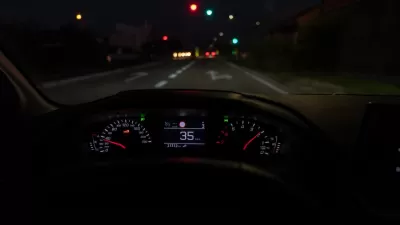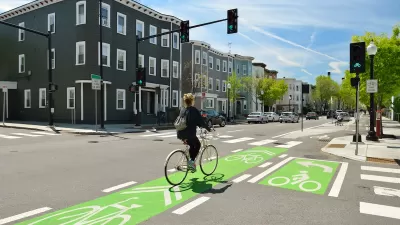In a new book, engineering professor Wes Marshall explains why American roads are so unsafe.

As many readers of Planetizen probably know, U.S. traffic fatalities are higher than those in other rich countries, and have risen in recent years (especially for pedestrians). This problem is at least partially rooted in American traffic engineering: engineers design streets that accommodate fast vehicle traffic at the expense of safety.
In Killed By A Traffic Engineer, engineering professor Wes Marshall explains some of the errors that led to this status quo.
First of all, American engineers receive almost no academic training about traffic, and even less training about safety. A student can graduate college with a civil engineering degree and pass a licensure exam while having taken no courses related to transportation (p. 307). Even engineers who take transportation-related courses learn little about road safety; one survey showed that among 117 universities with engineering programs, only 29 had a safety course (p. 309). Only four had more than one safety course (p. 310).
And perhaps because of this lack of academic training, traffic engineers often rely on research that is outdated or irrelevant. For example, 1930s research on industrial worker accidents found that for every accident that caused a major injury, there are 300 that caused no accidents (p. 94). Traffic engineers noticed this research and thought that “every accident has the same root causes” (id.)- in other words, that places that have very few small accidents also have very few major accidents.
But this point of view is incorrect in the context of auto traffic — a fast-moving highway might have very few minor accidents, but quite a few severe injuries and fatalities because if you are hit by a car going 60 miles per hour, you will be more severely injured than if you are hit by a car going 20 miles per hour. Because midcentury traffic engineers did not notice this difference between highways and factories, they thought streets with fast-moving traffic would be safer than they turned out to be.
Similarly, the American custom of 12-foot travel lanes is based on research that shows nothing about road safety outcomes, but instead on a 1945 study showing only that trucks “shift slightly more to the right” (p. 181) on narrower roads.
Early street research suggests that wider streets are no more dangerous than narrower ones. However, this research is based on pre-World War II streets that were no more than 24 feet wide (p. 289) — far narrower than many existing streets even in pedestrian-friendly New York City.
Even more serious research is too shallow to be valuable. A 1963 study suggests that cul-de-sacs are safer than grids because crashes at gridded residential intersections are more common than at intersections with less connected streets (p. 202). But this study focused on collisions within residential neighborhoods while overlooking crashes on nearby commercial streets (p. 203). But cul-de-sacs force traffic into the busier commercial streets, which tend to have wide lanes and fast traffic and are thus more dangerous (p. 204). As a result, neighborhoods with compact, connected street networks tend to have lower fatality rates (Id.)
Second, traffic engineers try to avoid blame for crashes by blaming human error (pp. 109-110) but overlook the fact that some street design rules are more likely to produce human error than others. For example, Marshall notes that many signalized intersections “give pedestrians the walk signal while we simultaneously allow drivers to turn directly into where we just told pedestrians they could safely walk.” (p. 114). In such a situation, drivers might be more likely to make fatal errors than at other intersections, because it is harder to both make a turn AND keep an eye out for pedestrians than do just do one or the other. To make matters worse, engineers often don’t have much data to work with. When a major crash occurs, police rely on reports from police, which in turn are based on often-dishonest statements by motorists at the scene of the accident (p. 234). This is especially a problem when a pedestrian is dead, because the police only hear the motorist’s side of the story.
Third, traffic engineers treat roads like buildings. When engineers, they calculate a “design load” and add materials big enough to handle that load in order to prevent structures from collapsing (pp. 155-56). When engineers reason by analogy, they favor bigger roads with higher design speeds. A leading engineering manual writes that a “design speed should fit the travel desires and habits of nearly all drivers expected to use a particular facility” (p. 157) — in other words, if some drivers want to drive 100 miles an hour, the road should be designed to make that safe. This may be a fine strategy for a limited-access highway, but creates a high risk of serious injury on streets that are used by slow-moving road users such as pedestrians and slow-turning vehicles. Marshall adds that most pedestrian deaths occur on a few “hot-spot corridors” — most of which are roadways with 1) five or more lanes 2) speed limits of 30 miles per hour or higher and 3) high traffic volumes (p. 179).
Marshall has catalogued a variety of flaws that have affected the design of American streets and traffic lights. However, I’m not sure that we can reform existing streets by reforming traffic engineering. Some drivers are perfectly content with existing unsafe roadways, and resist road diets and other attempts to slow down traffic. A reformed traffic engineering profession could make new development safer, but may not do as much as Marshall would like to improve existing streets.

Alabama: Trump Terminates Settlements for Black Communities Harmed By Raw Sewage
Trump deemed the landmark civil rights agreement “illegal DEI and environmental justice policy.”

Planetizen Federal Action Tracker
A weekly monitor of how Trump’s orders and actions are impacting planners and planning in America.

How Atlanta Built 7,000 Housing Units in 3 Years
The city’s comprehensive, neighborhood-focused housing strategy focuses on identifying properties and land that can be repurposed for housing and encouraging development in underserved neighborhoods.

In Both Crashes and Crime, Public Transportation is Far Safer than Driving
Contrary to popular assumptions, public transportation has far lower crash and crime rates than automobile travel. For safer communities, improve and encourage transit travel.

Report: Zoning Reforms Should Complement Nashville’s Ambitious Transit Plan
Without reform, restrictive zoning codes will limit the impact of the city’s planned transit expansion and could exclude some of the residents who depend on transit the most.

Judge Orders Release of Frozen IRA, IIJA Funding
The decision is a victory for environmental groups who charged that freezing funds for critical infrastructure and disaster response programs caused “real and irreparable harm” to communities.
Urban Design for Planners 1: Software Tools
This six-course series explores essential urban design concepts using open source software and equips planners with the tools they need to participate fully in the urban design process.
Planning for Universal Design
Learn the tools for implementing Universal Design in planning regulations.
Jessamine County Fiscal Court
Caltrans
Institute for Housing and Urban Development Studies (IHS)
City of Grandview
Harvard GSD Executive Education
Toledo-Lucas County Plan Commissions
Salt Lake City
NYU Wagner Graduate School of Public Service





























